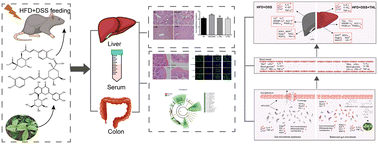Nonalcoholic fatty liver disease (NAFLD) is a complex metabolic disorder, manifested as oxidative stress, lipid accumulation, and inflammation of the liver. Tetrastigma hemsleyanum leaves (THL), which are rich in flavonoids and phenolic acids, have good anti-inflammatory, antioxidant, and hepatoprotective effects. However, it is unknown whether THL extracts can improve NAFLD and the underlying mechanisms are unknown. Hence, this study was designed to investigate the effects of THL extracts on NAFLD and perform a preliminary inquiry into the underlying mechanism based on the gut–liver axis. The results showed that THL extracts could reverse NAFLD-related oxidative stress, lipid accumulation, and inflammation. Additionally, the protective effect of THL extracts on the gut includes the maintenance of the intestinal barrier and the regulation of gut microbiota, which may be one of the mechanisms by which THL improves NAFLD. To be specific, in our study, THL extracts alleviated hepatic lipid accumulation and oxidative stress by regulating the expression of lipid synthesis/catabolism and the oxidative stress genes (SREBP-1c/ACC-1/PPAR-α/PPAR-γ/Keap1/Nrf2). In addition, THL extracts reduced damage to the intestinal barrier (ZO-1/Mucin2/occludin) and increased the relative abundance of Lactobacillales, Ruminococcaceae, and Bifidobacteriales in NAFLD mice. In short, THL extracts alleviated NAFLD-related oxidative stress, lipid accumulation, and inflammation in NAFLD mice which may be via the gut–liver axis (gut barrier integrity and gut microbiota).
